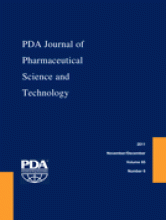Abstract
CONFERENCE PROCEEDING Proceedings of the PDA/FDA Adventitious Viruses in Biologics: Detection and Mitigation Strategies Workshop in Bethesda, MD, USA; December 1–3, 2010
Guest Editors: Arifa Khan (Bethesda, MD), Patricia Hughes (Bethesda, MD) and Michael Wiebe (San Francisco, CA)
Footnotes
-
↵* Co-chairs, on behalf of the PDA Cell Substrate Task Force.
- © PDA, Inc. 2011
PDA members receive access to all articles published in the current year and previous volume year. Institutional subscribers received access to all content. Log in below to receive access to this article if you are either of these.
If you are neither or you are a PDA member trying to access an article outside of your membership license, then you must purchase access to this article (below). If you do not have a username or password for JPST, you will be required to create an account prior to purchasing.
Full issue PDFs are for PDA members only.
Note to pda.org users
The PDA and PDA bookstore websites (www.pda.org and www.pda.org/bookstore) are separate websites from the PDA JPST website. When you first join PDA, your initial UserID and Password are sent to HighWirePress to create your PDA JPST account. Subsequent UserrID and Password changes required at the PDA websites will not pass on to PDA JPST and vice versa. If you forget your PDA JPST UserID and/or Password, you can request help to retrieve UserID and reset Password below.






